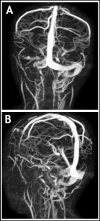Lemierre's syndrome in a child
- PMID: 35310801
- PMCID: PMC8899900
- DOI: 10.12669/pjms.38.ICON-2022.5773
Lemierre's syndrome in a child
Abstract
Lemierre's Syndrome (LS) is a rare syndrome most frequently due to an anaerobic organism, Fusobacterium Necrophorum. It is commonly a complication of an acute oropharyngeal infection, but there are exceptions to its presentations. In our case the cause of LS was otitis media caused by Streptococcus species. This is a rather unusual presentation of LS. LS is caused due to septic complications of oropharyngeal infections, which lead to thrombophlebitis of internal jugular vein leading to thrombosis formation. In this case report, we present a case of Lemierre's syndrome in a seven-year-old male child. The patient presented with high grade fever spikes and earache, which were unresponsive to oral antibiotics. LS was diagnosed in this patient on the basis of clinical, microbiological and radiological findings. After the diagnosis, treatment involved using broad spectrum antibiotics and anticoagulants, followed by surgery. Though role of anticoagulants is controversial in LS, but there is no specific guideline contraindicating the use of anti-coagulants. In our case, timely diagnosis and management enabled us to discharge the patient without any symptoms.
Keywords: Fusobacterium Necrophorum; Lemierre’s syndrome; Septic thrombosis.
Copyright: © Pakistan Journal of Medical Sciences.
Conflict of interest statement
Conflict of Interest & Grant Support: None.
Figures
References
-
- Karkos PD, Asrani S, Karkos CD, Leong SC, Theochari EG, Alexopoulou TD, et al. Lemierre's syndrome:A systematic review. Laryngoscope. 2009;119(8):1552–1559. doi:10.1002/lary.20542. - PubMed
-
- Syed MI, Baring D, Addidle M, Murray C, Adams C. Lemierre syndrome:two cases and a review. Laryngoscope. 2007;117(9):1605–1610. doi:10.1097/MLG.0b013e318093ee0e. - PubMed
Publication types
LinkOut - more resources
Full Text Sources


